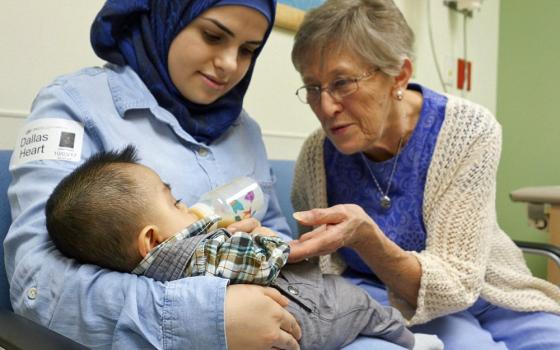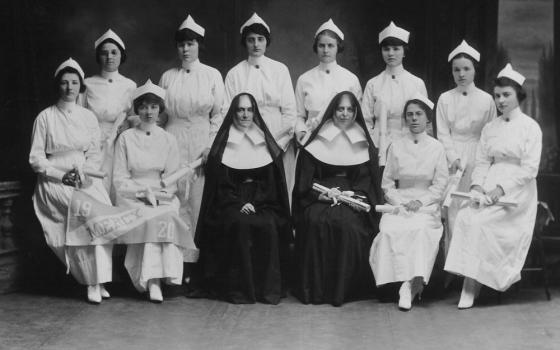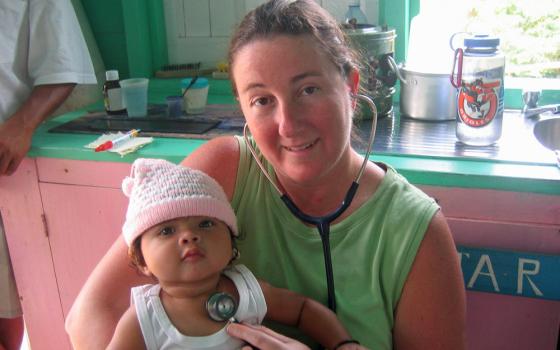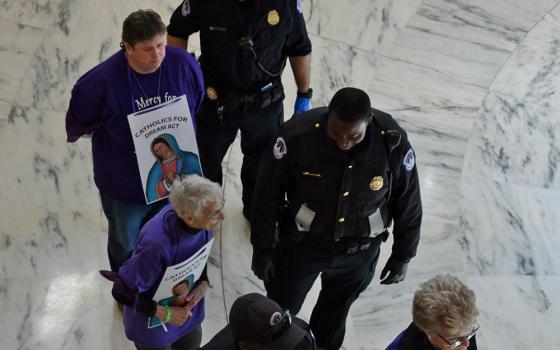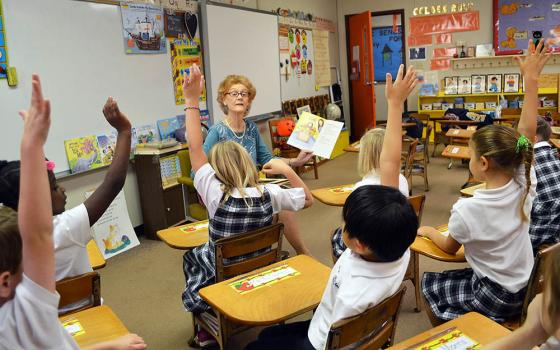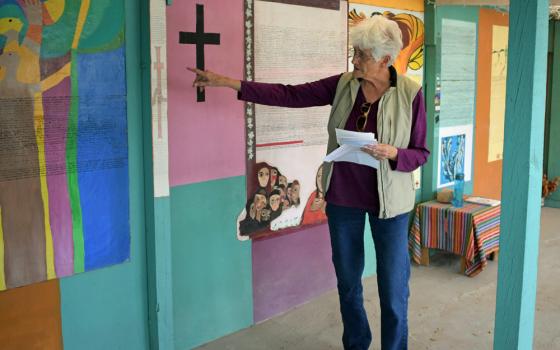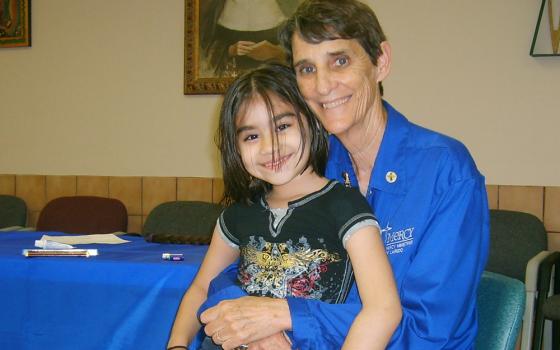When decisions are made at the dozens of hospitals and health systems the Sisters of Mercy of the Americas sponsor or co-sponsor, she is there.
When students get a Catholic education in the dozens of schools and colleges the Mercies sponsor or co-sponsor, she is there.
When people trapped in poverty find quality, affordable places to live through Mercy Housing, she is there.
She is Venerable Mother Catherine McAuley, foundress of the Sisters of Mercy in 1831, and though she died two years before the congregation came to the United States, her legacy is constantly invoked by the sisters who carry on her work.
On Dec. 21, the Sisters of Mercy of the Americas will celebrate the 175th anniversary of their arrival in Pittsburgh, where the seven sisters led by Mother Frances Xavier Warde opened schools and established the first hospital in Pittsburgh.
Commemorations — which centered around all those associated with the congregation performing 175 actions of service or prayer — have been taking place for months, and will wrap up Dec. 21 at the Pittsburgh motherhouse.
But almost two centuries later, it is McAuley that Mercy sisters so identify with. While Warde is honored, the congregation is concentrating on McAuley's sainthood cause before starting efforts on behalf of Warde.
"People in Pittsburgh have said to me, 'You Mercies talk about Catherine McAuley like she's coming to lunch,' " said Mercy Sr. Sheila Carney. "But our founder isn't some distant figure you'd have a hard time understanding, but a woman who positioned us in the world."
Carney is a former president of the Pittsburgh Community of the Sisters of Mercy. Currently she is the special assistant to the president for Mercy Heritage at Carlow University in Pittsburgh and the vice postulator for the Cause for Canonization of Catherine McAuley, representing the Americas.
Today, the Sisters of Mercy of the Americas is the largest single congregation of women religious in the United States, with 2,608 sisters and 3,335 associates, Carney said, but that is not the structure McAuley envisioned. Rather, when McAuley sent sisters on a mission, they established their own, independent foundation so it could be tailored to the needs of the area they served.
"When the Sisters of Mercy went to a new place, they always started a school for the poor and visited the sick, but beyond that, they would look at the needs of the place they were in," she said. "Who are these people, what are their needs, and how can we meet their needs?"
The Mercy Sisters have been a cornerstone of women religious in the United States.
"They've had a very important and significant influence," said Carol K. Coburn. "They were one of the earliest groups here, and they're very large."
Coburn is a professor of religious studies and women's and gender studies at Avila University in Kansas City, Missouri, who has published and presented extensively on topic of American Catholic sisters.
Some of that, she said, was due to timing: The sisters arrived here in 1843, the Irish potato famine, which sparked a massive wave of Irish immigration to the United States starting in 1845.
There was also opportunity, Coburn said. In 19th century Ireland, women had to have a sizeable dowry to marry, and most convents required one, as well. But congregations of women religious in the United States did not – meaning many young Irishwomen had a choice between poverty and spinsterhood, or joining an order in the United States where they had opportunities for education and meaningful work. There were also many Irish Catholic families in the states who were happy to encourage their daughters to join the convent.
"It was a scary adventure, but it was an adventure," she said. "It was far better than your prospects staying in Ireland."
That draw continued in the 1900s, when religious life meant it was possible — and often required for occupations such as teaching — for women to get a college education.
Kathleen Sprows Cummings, a history professor at the University of Notre Dame who has written extensively about the Catholic Church and women religious in particular, said the Mercies also had an outsized influence in the United States because they were involved in the three pillars of service: education, nursing and social services.
"They really did everything, so they were ubiquitous in American culture," Cummings said. "The story of Catholicism in America really shifted from a French dimension to an Irish dimension, and the Mercies were really on the vanguard of that. …It's a remarkable story."
Growth and consolidation
Carney said that by the 1920s there were Sisters of Mercy across the United States and Latin America — there were 39 motherhouses and more than 5,000 sisters in the United States alone — and there was talk of consolidation. Instead, in 1929 the Sisters of Mercy of the Union was founded, merging many of the congregations into one single entity with nine provinces. Seventeen communities remained independent.
Over the next decades, a federation of all the Mercy congregations was formed and in the 1970s, a common constitution was published for each of them.
"At that point we asked, 'Why aren't we one?' " Carney said.
So in 1981, when the Sisters of Mercy celebrated the 150th anniversary of their founding, work began to consolidate the separate congregations into one. Ten years later, on July 20, 1991, the Sisters of Mercy of the Americas was born with all but one congregation joining the new entity. The Religious Sisters of Mercy of Alma, Michigan, is now the only independent Mercy congregation in the United States; the Sisters of Mercy of the Americas has missions in 13 countries.
"At the time there certainly were some fears around loss of autonomy and independence, but the reality was that prior to 1991, we had had a federation for 15 or 20 years, so we were already sharing resources, our novices were doing programs together," said Mercy Sr. Patricia McDermott, the congregation's president. "There really was a sense that together we could do better and do more. Being large, you can make decisions out of strength, not out of need."
Regardless of size or location or available resources, she said, the congregation has and will always be about serving those most in need.
"All along the way, it's been about seeing the possibilities, the hope that would be engendered, seeing how we can make a difference for the suffering world," McDermott said. "Those are always the motivations for us."
Internationally, the Sisters of Mercy have the Mercy International Association, which does not have any governance powers, but is a way to extend the sisters' reach. It was founded to provide ownership of the first House of Mercy McAuley built in Dublin, Ireland, and now has a communications department, an international justice agenda and an NGO seat at the United Nations.
The Sisters of Mercy in Ireland are one of four congregations of women religious there who have come under scrutiny and criticism for their part in running Magdalene laundries in decades past, where women were brought by the state or their families for being unmarried and pregnant, or other reasons, and used as unpaid, forced labor. The Mercy Sisters have noted they were not compensated for caring for the women and that the laundries were not profit-making ventures. "We acknowledge fully the limitations of the service we provided for these women when compared with today's standards and sincerely wish that it could have been different," the congregation said in a statement to GSR. "We trust that the implications of the changed context are understood by the wider society."
Health care, housing and education
Across the U.S., there are dozens of health systems, hospitals and clinics that include "Mercy" in their name and a history that can be traced back to the Mercy Sisters, even if they are no longer a sponsored ministry. The Mercy health system based in St. Louis, for example, which was started by the sisters but is no longer associated with the congregation, was named one of the top five large U.S. health systems and includes more than 40 acute care and specialty hospitals, and 800 physician practices and outpatient facilities.
Today, the Sisters of Mercy sponsor or co-sponsor six health systems in the United States, 19 hospitals and health care centers, a mobile clinic, a senior living center and an assisted care facility, as well as health care ministries in Belize, Guam, Guyana, Peru and the Philippines.
"We've have an extraordinary legacy in health care," McDermott said. "We still have a number of sisters in governance roles — they're not administrators or CEOs any longer, but we take delight in the way Catholic health care has grown. It's a testament to our lay colleagues that the ministry has grown and been able to expand."
That legacy, she said, came from McAuley's charge to serve those in need of health care.
"The accompaniment of immigrants has always been our story of religious life," McDermott said. "And today, with immigration so front and center, it's a natural for us. It's amazing that 175 years later, our accompaniment of immigrants is still very central to our identity and our mission."
And while the Sisters of Mercy obviously have an Irish heritage, only the ethnicities have changed over the centuries, she said, not the needs.
"Those early immigrant populations, whether Irish, Czech, Polish or Italian, they all had the same dilemma," McDermott said. "And today, for those who are Hispanic and for many other ethnicities, it's the same."
In 1981, the Sisters of Mercy in Omaha, Nebraska, formed Mercy Housing Inc., not to provide affordable housing, but to help people stabilize their lives and improve their health and education — with affordable housing as the vehicle. The ministry grew out of the belief that the people being treated in the sisters' health care facilities would never truly be healthy unless they had safe, stable housing they could afford.
"The balance between direct service and systemic change has been a wonderful dynamic," McDermott said. "Part of our legacy is that we've developed institutions to address systemic change."
Today, Mercy Housing is one of the largest housing organizations in the country, serving more than 75,000 people in 42 states.
While the congregation has largely stepped out of directly operating health care facilities, it remains the driving force in dozens of schools and universities through two sponsored ministries.
All of those efforts, sisters say, remain focused around the aims of McAuley.
"Associates say things to me like, 'When I get up in the morning, I ask Catherine McAuley to help me,' " said Mercy Sr. Mary Sullivan. "I think that's part of the gift of God of religious life to the church, to be an inspiration to the whole church, not because we're perfect, but because we tried."
Sullivan is a professor emerita and dean emerita at the Rochester Institute of Technology and the author of numerous works on McAuley, including a biography, The Path of Mercy: The Life of Catherine McAuley.
"It's not difficult to write about her — she is still today an abiding inspiration to all Sisters of Mercy all around the world. She's not a dead, long-ago founder, people are very interested in her."
Still inspiring
In addition to being at the center of religious life for Sisters of Mercy, McAuley is the center of a study by the Vatican into whether she interceded in a miracle.
In September, the Diocese of Tulsa, Oklahoma, finished its investigation into the miraculous recovery of a small boy, and sent the results to the Congregation for the Causes of the Saints in Rome. Should the miracle be confirmed, she will become Blessed Catherine McAuley. A second miracle could lead to canonization.
"The view of many of us is that Catherine McAuley could be an even greater inspiration to the church if she were canonized," Sullivan said.
What makes her such an inspiration, even two centuries later?
"Her character and personality. She was a very loving, practical, humorous and merciful person," Sullivan said. "She had a vision of mercifulness to all God's people, especially the so-called least of these, and that vision got passed on to other people. Even today, you'll find Sisters of Mercy saying, 'I think this is something Catherine McAuley would want me to do.' "
What inspired McAuley, Sullivan said, was simple: She focused on the life of Jesus Christ.
"She used to speak often about our trying to resemble Jesus Christ in one thing at least," she said. "She felt a desire and obligation to try to resemble Jesus Christ in his mercifulness."
McDermott said she is in awe of how small efforts added up to 175 years of major efforts by thousands of sisters.
"Seven sisters came to Pittsburgh," McDermott said. "They didn't have a vision of coming to the United States, they were coming to Pittsburgh to educate the poor and heal the sick. It was a small effort. But the missionary sense that grew out of that was wonderful."
[Dan Stockman is national correspondent for Global Sisters Report. Follow him on Twitter @DanStockman or on Facebook.]
*This story has been updated with additional information about the influence of the Sisters of Mercy on women religious in the United States, including commentary by Coburn and Sprows Cummings. A caption has been updated to correctly identify Sister Pat Murphy.
